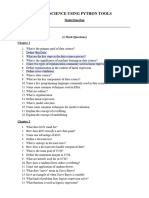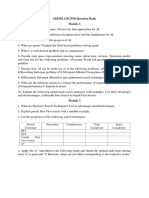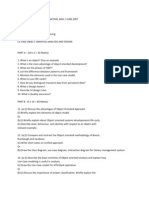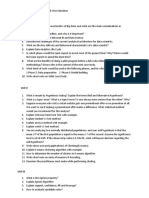0 ratings0% found this document useful (0 votes)
52 viewsData Analytics Assignment
The document contains two assignments with multiple questions about data analysis, machine learning, data mining, and association rule mining. It asks for definitions of key terms, descriptions of processes like the data analytics lifecycle and model evaluation, and examples of applying algorithms like Apriori to transactional data to find support and confidence of rules. The assignments cover fundamental concepts in data science and require explanations, comparisons, examples, and solving past year questions.
Uploaded by
Great KhalliCopyright
© © All Rights Reserved
Available Formats
Download as DOCX, PDF, TXT or read online on Scribd
0 ratings0% found this document useful (0 votes)
52 viewsData Analytics Assignment
The document contains two assignments with multiple questions about data analysis, machine learning, data mining, and association rule mining. It asks for definitions of key terms, descriptions of processes like the data analytics lifecycle and model evaluation, and examples of applying algorithms like Apriori to transactional data to find support and confidence of rules. The assignments cover fundamental concepts in data science and require explanations, comparisons, examples, and solving past year questions.
Uploaded by
Great KhalliCopyright
© © All Rights Reserved
Available Formats
Download as DOCX, PDF, TXT or read online on Scribd
You are on page 1/ 2
Assignment
Q.1 Short Answer Question:
1. Define class imbalance.
2. What is model evaluation?
3. Define the term matrix and classifier.
4. Define descriptive analysis.
5. Define supervise learning.
6. Define classification and regression.
7. List AI application.
8. What is purpose of apriori algorithm.
9. Define frequent itemset.
10.What is closed and maximal itemset.
11.Define characterization and discrimination.
12.List applications of data mining.
Q.2 Long Answer Question:
1. Difference between data analysis and data analytics.
2. With the help of diagram describe lifecycle of data analytics.
3. Write a short note on: I) data science II) linear model III) Accuracy
IV) Confusion Matrix V)Prescriptive Analytics
4. How to evaluate model? List its types.
5. Advantages and Disadvantages of machine learning.
6. How to train and validate a model? Describe in detail.
7. What is AI? What is its purpose? State its advantages and disadvantages.
8. What is clustering? explain with example.
9. What is association rule mining? Describe with the example.
10.Explain I) Predictive analysis.
II) Cluster analysis. III) Outlier analysis.
11.Explain different data formats in brief.
12.What is structure and unstructured data? Distinguish between them
13.The following database has four transactions:
T1 {R, A, D, C}
T2 {D, A, B, E, C}
T3 {B, A, C, E}
T4 {C, A, D}
Find the support and confidence for following rule.
A->D, D->A, AB->D, BD->A, D->AB, B->D
Q. 3 Solve Last year university question papers (Any Two).
You might also like
- Data Analytics - Unit-1,2,3, & 4 questions - AssignmentNo ratings yetData Analytics - Unit-1,2,3, & 4 questions - Assignment6 pages
- Branch: Computer Science & Engineering Semester: 4 Sem Subject: Artificial IntelligenceNo ratings yetBranch: Computer Science & Engineering Semester: 4 Sem Subject: Artificial Intelligence5 pages
- Ad3301-Data Exploration and Visualization Important Questions For Ciat-1No ratings yetAd3301-Data Exploration and Visualization Important Questions For Ciat-13 pages
- AIML - 21CS54 - IA3 - Preparatory - Question Bank-1No ratings yetAIML - 21CS54 - IA3 - Preparatory - Question Bank-13 pages
- OOSD With C++ Important Question Bank All Units_Last Five YearNo ratings yetOOSD With C++ Important Question Bank All Units_Last Five Year5 pages
- 21CS54 SIMP Questions - 21SCHEME: To Pass and Score Decent Just Study Module 1,2 3No ratings yet21CS54 SIMP Questions - 21SCHEME: To Pass and Score Decent Just Study Module 1,2 35 pages
- UNITwiseUniversityQuestion Bank - StudentsNo ratings yetUNITwiseUniversityQuestion Bank - Students12 pages
- Data Mining Question Bank Chapter-1 (Introduction To Data Warehouse and Data Mining) Expected Questions 1 Mark QuestionsNo ratings yetData Mining Question Bank Chapter-1 (Introduction To Data Warehouse and Data Mining) Expected Questions 1 Mark Questions6 pages
- D. Patel Institute of Technology Department of Information Technology Subject: Data Mining and Business Intelligence (2170715) A.Y 2020-2021No ratings yetD. Patel Institute of Technology Department of Information Technology Subject: Data Mining and Business Intelligence (2170715) A.Y 2020-20212 pages



























































